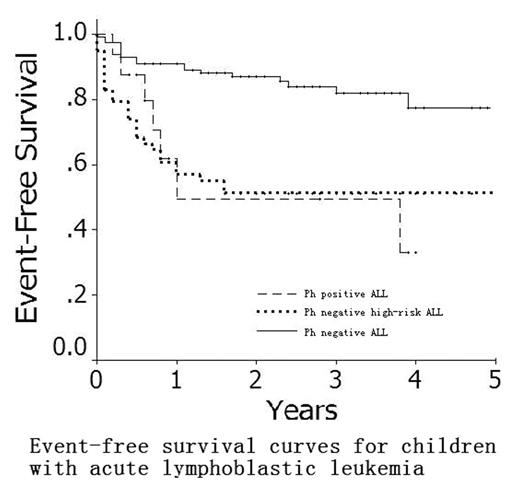Abstract
Objective To explore the incidence, clinical characteristics and prognosis of childhood acute lymphoblastic leukemia (ALL) with t(9; 22).
Methods All of the clinical characteristics of the 325 childhood ALL patients from November, 1998 to November, 2003 were analysised. The statistics was done by SPSS 10.0.
Results There were 129 cases of high-risk ALLs in 325 Childhood ALL patients, with 95 males and 34 females. BCR-ABL fusion gene was found in 16 cases by RT-PCR, accounting for 4.9%. All of them were m-BCR-ABL. There were 12 males and 4 females among 16 Ph positive ALLs. The mean age at diagnosis was 8.54±3.36 (3.5 to 12.5) years, 50.0% of which were older than 10 years. The percents of patients who had initial WBC count more than 100×109/L, myeloid antigen coexpression, hypodiploidy, and ALL-L2 were 37.5%, 53.8%, 33.3%, and 62.5%, respectively. By comparison, the percents of age (older than 10 years), initial WBC count (more than 100×109/L), myeloid antigen coexpression, prednisone poor response (PPR), and CR over 35 days in the Ph positive ALLs were higher than that in the negative ALLs. No statistic difference was found in sex and L2 proportion between them. Moreover, no difference was found between Ph positive ALLs and negative high-risk ALLs in the mentioned parameters, except for the myeloid antigen coexpression. Four-year event-free survivals (EFS) and disease-free survivals (DFS) were 77.4% and 79.4, respectively, in Ph negative ALLs, but were 33.0% and 47.7%, respectively, in Ph positive ALLs (P<0.01). In Ph negative high-risk ALLs, the four-year EFS and DFS were 51.2% and 54.6%, respectively, both of which had no statistic difference between Ph positive cases. Only one Ph positive child received allogeneic BM transplantation, who remained in EFS at the time of this analysis.
Conclusion The percent of t(9; 22) in Chinese childhood ALLs had no difference with the report abroad. There were statistic differences between Ph positive and negative childhood ALLs in age, initial WBC count, early response to therapy, and four-year EFS and DFS, but no difference was found between Ph positive ALLs and Ph negative high-risk ALLs, except for the immunophnotype. Aggressive treatment, such as high-dose chemotherapy with allogeneic BM transplantation should be considered for these patients to improve survival.
Event-free survival curves for children with acute lymphoblastic leukemia
Event-free survival curves for children with acute lymphoblastic leukemia
Author notes
Corresponding author


This feature is available to Subscribers Only
Sign In or Create an Account Close Modal